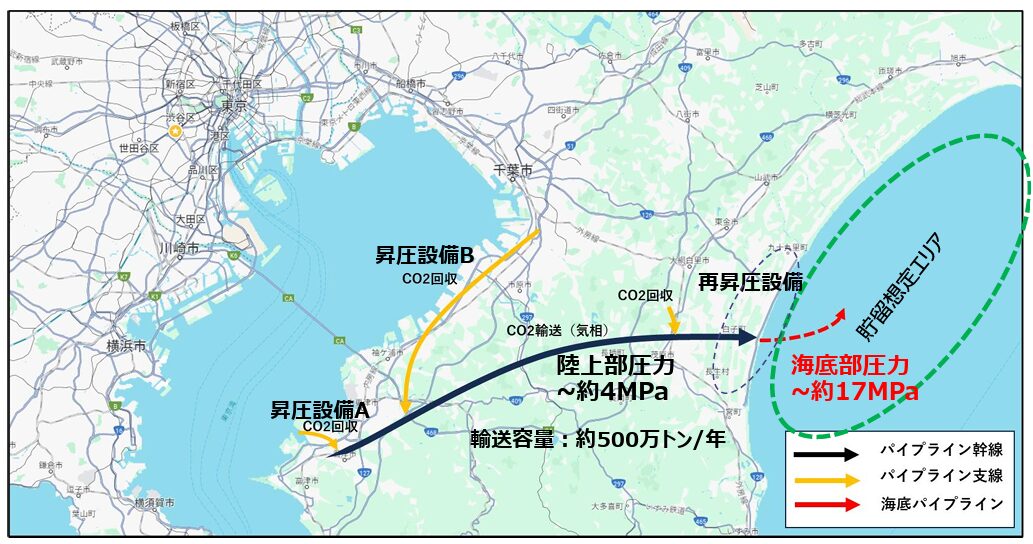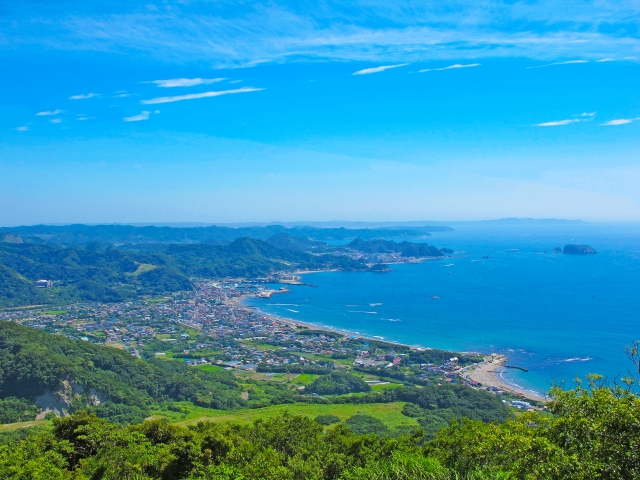Plans are moving forward to construct an 80km tunnel across the Boso Peninsula. However, this tunnel does not carry vehicles or people, but rather transports carbon dioxide (CO2) emitted from the industrial area in the western shore of the Boso Peninsula to its eastern shore. It has become clear that the project, known as the “Metropolitan Area CCS Project,” is being steadily advanced without public knowledge.
*CCS: Carbon Capture and Storage
What is the “Metropolitan Area CCS Project”?
This plan involves separating and capturing CO2 emitted from factories in the Keiyo Industrial Zone on the western shore of the Boso Peninsula, transporting CO2 via a pipeline across the peninsula to the eastern shore, and storing it deep under the ocean floor in the Pacific. The project is being advanced as part of an initiative promoted by the Japan Organization for Metals and Energy Security (JOGMEC), with the aim of commencing operations by 2030. Surveys and other preparatory work have already begun, and public information sessions for residents in the areas where the pipeline will pass are being held sequentially.

Business operators and their responsibilities
This project is being carried out by “Metropolitan Area CCS, LTD.”, a joint venture established in February 2025 by INPEX (85% equity stock) and Kanto Natural Gas Development (15% equity stock). The company is responsible for CO2 transportation and storage, technical evaluation of CO2 storage areas, route planning for the pipeline, and feasibility assessments for commercialization.
CO2 emitted from multiple industries in the Kimitsu area of Nippon Steel East Japan Steel Works and the Keiyo Industrial Zone will be separated and recovered in the same area. In this project, Nippon Steel will be responsible for CO2 separation and recovery, while Metropolitan Area CCS (joint venture of INPEX and Kanto Natural Gas Development) will be responsible for transportation and storage.
Public briefing sessions ahead of investment decision at the end of 2026
Two public information sessions for residents in the Sodegaura area were held in July 2025 at Sodegaura City’s civil hall. Notices for these sessions were circulated only to residents in areas within Sodegaura City directly under the pipeline route and in other cities, and so the sessions were held without being publicly disclosed in a way accessible to outsiders. The sessions were organized and conducted by the Metropolitan Area CCS company, and Nippon Steel did not participate. The title on the material distributed at the session (not approved for public release) was “Design work related to ‘Metropolitan Area CCS Project’ one of the Japanese Advanced CCS Projects“, but there is no explanation about “CC (carbon capture)” or “S (storage)” aspects of this CCS project, only the pipeline route plan. Regarding risks, INPEX’s explanations were extremely limited, only emphasizing “safety.”
In principle, a project on this scale should undergo environmental assessment procedures, provide clear explanations, and address opinions and questions. However, when the Act on Carbon Dioxide Storage Business (CCS Business Act) was debated in the Diet, although the necessity of an environmental assessment was pointed out, it was passed and enacted as originally drafted without making projects subject to assessment, meaning there is no legal obligation. Surveys will continue moving forward toward the end of 2026, when the final investment decision is scheduled to be made, but there is no legal guarantee that dialogue with residents or sufficient explanations will be provided.
Pipeline Route
The business operator (INPEX) explained that the specific route for laying the pipeline across the Boso Peninsula has not yet been finalized. However, a concept for a route passing through nine areas has already been drawn, including Kimitsu City, Kisarazu City, Sodegaura City, and Mobara City, and steady progress is being made in research and preparatory work for digging the tunnel. While they stated that feasibility and economic viability would be assessed after conducting surveys, it is clear that the pipeline’s construction has already effectively been decided.
In urban areas, pipes with a diameter of approximately 73 centimeters will be buried at a depth of about 2 meters along main roads and other locations. In certain areas, such as river crossings and railway crossings, the pipes will be buried at even greater depths underground. Regarding earthquake resistance, INPEX explained that the underground tunnels will be reinforced with mortar, and highly flexible pipes that can bend without breaking will be used, enabling the system to withstand earthquakes of magnitude 7.
In recent years, accidents have occurred where water leaked or ground collapsed due to aging water pipes. Who can guarantee that CO2 pipelines will remain safe for decades to come? INPEX did not mention who would bear responsibility if something happened due to natural disasters, or who would be responsible for maintaining the pipelines.
Why the need to build a pipeline across the Boso Peninsula?
Let’s return to the fundamental question: Why is it necessary to transport CO2 across the entire Boso Peninsula through an approximately 80-kilometer pipeline?” In response to this question raised by residents at the public briefing, INPEX answered: “Since there are water-soluble gases under the seabed in the eastern shore area (Pacific side), geological data is available that indicates a high probability of a barrier layer (a geological layer that can act as a lid to store CO2 underneath) in the proposed storage area. That increases the probability of CO2 injection.” INPEX also stated that they have not investigated whether suitable sites exist off the western shore of the peninsula (near the emission sources) due to the costs involved. Can residents truly be expected to accept a project that involves transporting and storing CO₂ across the entire peninsula, when proper surveys haven’t been conducted?
As an example,
Let’s say Mr. A doesn’t want to bury his garbage in his own yard, and Mr. B’s backyard looks possibly easier to bury in, even though it is much farther away. Then Mr. A decides to transport his garbage through Mr. C’s yard, and dispose of it in Mr. B’s yard, even though he isn’t even sure that Mr. B’s yard is actually a good place to dig a hole. How would you feel?
This is an extreme analogy, but in reality, plans are moving forward to construct an 80-kilometer pipeline at enormous cost—without even investigating whether suitable sites exist off the western shore, and without any certainty about how much CO2 can actually be stored in the sites off the eastern shore
The Project Will be Funded by Our Taxes
At the public information session, one resident asked if it would be cheaper to transport CO2 by ship rather than constructing a new pipeline. INPEX responded that, according to calculations, transporting CO2 over long distances (200 km or more) could be cheaper by shipping, but shorter distances could be cheaper by land transportation, and since this project is less than 200 km, it is more cost-effective to transport the CO2 by land. But does this estimate properly account for the cost of constructing and burying the pipeline underground? INPEX did not answer the question about the costs of this project, stating that they would “calculate them later.” Since this project is one of the government’s “Advanced CCS Projects”, taxpayer money is being invested. However, it is impossible to determine from the publicly available documents how much the entire process will actually cost.
Moreover, INPEX has not estimated how much CO2 will be emitted as a result of this project. In order to store 1.2 million tons of CO2 annually, how much CO2 will be emitted during its preparation? It is unclear whether the operators can store as much CO2 as they are planning to in the eastern project sites until they actually try. In any case, it is crucial that the CO2 emission amount from the project itself and the total costs for the entire process are disclosed to the public.
A stronger effort must be made to invite a diverse group of stakeholders to the public briefing sessions, such as residents across the entire region, people working in the fishing industry, and other stakeholders whose livelihoods depend on the region. Beyond briefings only on the pipeline construction, explanatory sessions should be held regarding Nippon Steel’s separation and capture scope and Metropolitan CCS’s storage scope (conceptual design of marine facilities and preparation, drilling, and appraisal of evaluation wells). Various concerns should be shared and discussed with all stakeholders before a final investment decision is made.
Related Documents
FY2024 “Survey on the Implementation of Japan Advanced CCS Projects” Report on the result of the Metropolitan Area CCS Project, dated July 9, 2025. (PDF, written in Japanese)
INPEX:Metropolitan Area CCS Project (Link)
Other Information
Reference Materials for the Interim Summary of the CCS Long-Term Roadmap Review Meeting (in Japanese)

